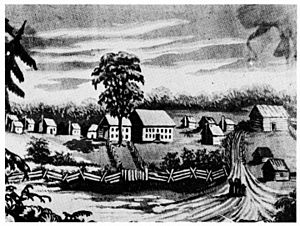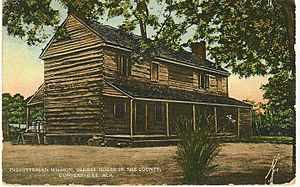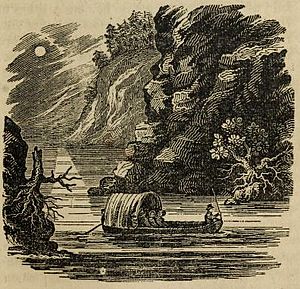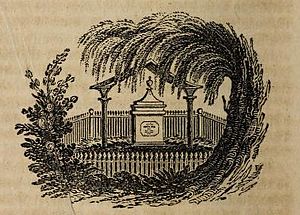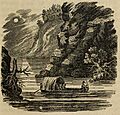Catharine Brown (Cherokee teacher) facts for kids
Catharine Brown (born around 1800 – died July 18, 1823) was a brave Cherokee woman. She was a missionary teacher at the Brainerd Mission School. Catharine was the first Cherokee person at the mission to become a Christian. She was also the first Native American woman to have many of her writings published while she was alive.
Contents
Early Life of Catharine Brown
Catharine Brown was born around 1800. Her parents were John Brown, known as Yau-nu-gung-yah-ski in Cherokee, and Sarah Webber Brown, or Tsa-luh. They lived about 25 miles southeast of the Tennessee River. This area was called Tsu-sau-ya-sah by the Cherokee people. Today, it is part of the Wills Valley in Alabama, between the Raccoon and Lookout mountains.
Catharine's family was well-off. Her father was a "headman" in the Creek-Path Cherokee community. Even though her parents were considered very smart among the Cherokee, they did not understand English.
Brainerd Mission School Experience
In 1816, a missionary named Rev. Cyrus Kingsbury asked the Cherokee Council for permission to build schools. The Cherokee leaders liked the idea. Kingsbury started the first school board for the Cherokee. He then moved on to work with the Choctaw Nation.
The board chose a place called Chick-a-mau-gah for the first school. Later, it was named Brainerd, after David Brainerd, a famous missionary to Native Americans. In the spring of 1817, Moody Hall and Loring S. Williams arrived with their wives to help. The school soon opened.
News of the school spread quickly. It reached Catharine, who lived about 100 miles away. Catharine was seventeen at the time. She had learned some English while staying with a Cherokee friend. She asked her parents if she could go to the mission school, and they agreed. On July 9, 1817, Catharine became a student at Brainerd Mission School.
Catharine was a quick learner. In just three months, she learned to read and write in English. This was amazing progress for anyone at that time. Catharine became very interested in everything she learned. Around January 1818, she became a Christian and was baptized by the missionaries.
Women at the Mission
The community of women at the Brainerd Mission was a comfort to Catharine. This is clear from her letters when she was away from them. In some ways, it was like the communities of Cherokee women she grew up with. Cherokee women often lived separate lives from men. They worked together to grow crops. They also helped each other with childbirth and childcare.
At Brainerd, the women's lives were similar to those of middle-class white women of that time. They were expected to be religious, pure, and obedient. They often spent time together to support each other in these values. The women at the mission grew very close. They worked together to run the mission and care for each other. Catharine missed this strong sense of sisterhood when she was away from Brainerd.
Teaching at Creek-Path Mission
The years Catharine spent at Brainerd were difficult for Cherokee society. American settlers were moving closer, and there was pressure on the Cherokee to adopt American ways. Some Cherokee people wanted to keep their "old ways." Others, like Catharine's family, welcomed the changes. For them, the mission and school offered hope for the future of the Cherokee people.
The missions also offered a sense of community. They included women, though in less powerful roles. This was different from the past, when Cherokee women held important positions in town councils.
In February 1820, Catharine's father asked for a mission to be started for boys at Creek Path. The Creek Path Mission opened in March 1820. It was started by Rev. Daniel S. Butrick and John Arch, a young Cherokee man known as A-tsi. Soon after, a girls' school was also requested. Catharine was chosen to teach there because she had grown up in Creek Path. She felt mixed emotions about leaving her friends at Brainerd. But she also felt it was very important to do this work.
Illness and Death
In 1821, Catharine’s brother, John, became very sick with tuberculosis. Even though Catharine wanted to return to her friends and work, her Cherokee duty meant she needed to help care for her brother. At that time, some Cherokee people believed physical sickness was caused by spiritual problems. They thought it could be cured with special rituals.
Many Christian missionaries did not agree with this. However, many Christian Cherokees still used traditional medicine. So, Catharine went with John’s wife to a sulphur spring in Alabama. The Cherokee believed water had healing powers. One practice was "going to water," where they bathed daily in running water to purify themselves. It made sense to seek healing for John at the spring.
However, the journey was long, and John's health got worse. They stopped at another spring and made camp. He drank and bathed in the water, but it did not help. Six months later, John passed away.
After her brother died, Catharine went home to care for her parents. They were in their sixties and living in John’s home. She visited the missions at Creek Path and Brainerd. But she felt it was her duty to care for her aging parents. In a letter to her other brother, David, she hoped to move west. She was excited about spreading her values there.
However, Catharine had started showing signs of the same illness that took her brother. She sought help from Dr. Alexander Campbell, a white doctor in Alabama. As her condition worsened, her parents became desperate. They turned to traditional healers, which upset the missionaries at Brainerd. The traditional treatments did not help much. After she had severe bleeding in her lungs, her parents sent for the missionaries.
A week later, Dr. Campbell arrived, but Catharine was very ill. He had her moved to his home for constant care. Her mother and sister joined her on the journey by stretcher, canoe, and carriage. On the morning of July 18, 1823, Catharine Brown died at Dr. Campbell’s home. He reportedly said, "Thus fell asleep this lovely saint, in the arms of her Savior."
Impact and Legacy
After Catharine's death, the missionaries at Brainerd asked Rufus Anderson to write about her for their magazine, the Missionary Herald. So much information was found that the American Board published a whole book called Memoir of Catharine Brown, A Christian Indian of the Cherokee Nation.
This book praised the missionaries' efforts to spread Christianity to Native Americans. However, some felt it suggested that Catharine had lost her Cherokee identity. In later years, Catharine’s writings were used in discussions about moving the Cherokees and other tribes to Indian Territory (now Oklahoma).
At one point, some literary critics saw her as a victim of early missionaries. They thought her conversion led to a loss of her identity. But over time, she began to be seen differently. Many now view her as a woman who showed the strength, survival, and leadership of the Cherokee culture. Later collections of her letters and diary confirmed Catharine’s important place in early 1800s culture. Her story has had a lasting effect on how Americans see Native Americans.
Letters and Works
- The Collected Writings of Catharine Brown, 1818-1823 by Catharine Brown, edited by Theresa Strouth Gaul part of the series Legacies of Nineteenth-Century American Women Writers Series published by the University of Nebraska Press 2014, ISBN: 9780803240759
Images for kids



